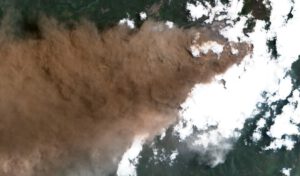 The phase of increased activity at Fuego that began yesterday escalated into a paroxysm. Volcanic ash rose to an altitude of 7600 m and drifted 200 km to the west. The ash cloud posed a danger to air traffic. Lava fountains shot several hundred metres into the air and a lava flow passed through the Ceniza Gorge, creating debris avalanches. Last, but not least, pyroclastic flows went off. They flowed through the Seca y Santa Teresa gorges to the west of the volcano. The national road RN 14 was closed and the Civil Protection CONRED ordered the evacuation of more than 1000 people from five villages near the volcano.
The phase of increased activity at Fuego that began yesterday escalated into a paroxysm. Volcanic ash rose to an altitude of 7600 m and drifted 200 km to the west. The ash cloud posed a danger to air traffic. Lava fountains shot several hundred metres into the air and a lava flow passed through the Ceniza Gorge, creating debris avalanches. Last, but not least, pyroclastic flows went off. They flowed through the Seca y Santa Teresa gorges to the west of the volcano. The national road RN 14 was closed and the Civil Protection CONRED ordered the evacuation of more than 1000 people from five villages near the volcano.
Eruptions
News about eruptions and volcanoes can be found in this category. It is updated frequently. Volcano expert and journalist Marc Szeglat reports live from his expeditions to volcanoes.
Shiveluch on Kamtchatka erupts
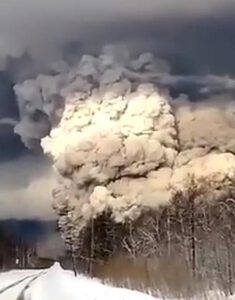 On Russia’s Kamchatka Peninsula, Shiveluch continues to be active, ejecting high rising ash clouds associated with the generation of pyroclastic flows. According to the Tokyo VAAC, volcanic ash reached an altitude of 9,500 m this morning and is spreading over a large area to the southeast of the volcano. It is very likely that further ash precipitation will occur in the village of Kljutschi, where heavy ash precipitation already occurred after the initial ignition of the volcano, covering the entire village with a brown layer of ash, causing massive problems and bringing public life to a standstill. In the meantime, it is said to be up to 20 cm thick. It must be removed from house roofs as soon as possible, because when it gets wet, the ash turns into a layer that weighs tons and can cause roofs to collapse. Since it is still winter on Kamchatka, precipitation will first fall as snow, which can be removed along with the ash. With the onset of snowmelt, however, lahars may then form on the volcano.
On Russia’s Kamchatka Peninsula, Shiveluch continues to be active, ejecting high rising ash clouds associated with the generation of pyroclastic flows. According to the Tokyo VAAC, volcanic ash reached an altitude of 9,500 m this morning and is spreading over a large area to the southeast of the volcano. It is very likely that further ash precipitation will occur in the village of Kljutschi, where heavy ash precipitation already occurred after the initial ignition of the volcano, covering the entire village with a brown layer of ash, causing massive problems and bringing public life to a standstill. In the meantime, it is said to be up to 20 cm thick. It must be removed from house roofs as soon as possible, because when it gets wet, the ash turns into a layer that weighs tons and can cause roofs to collapse. Since it is still winter on Kamchatka, precipitation will first fall as snow, which can be removed along with the ash. With the onset of snowmelt, however, lahars may then form on the volcano.
Mauna Loa: Eruption continues
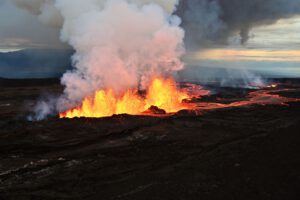 The eruption on Hawaii’s Big Island continues, and lava flows from the northeast rift of Mauna Loa volcano. During the day yesterday, the height of the lava fountains from fissure 3 was reduced to a maximum of 25 meters. On the LiveCam, it can be seen that the lava fountains are still active today. A wall of cinders is slowly forming around the active part of fissure 3. The fountains feed a lava flow with several arms. The most advanced one was moving towards the saddle road yesterday at noon at a speed of 24 meters per hour and was still 5800 meters away from it. The slope is slowly decreasing in this area, so the lava flow will continue to slow down. At the same time, the lava front is getting wider. The USGS wrote in its last update that the lava flow will take about 2 more days to reach the saddle road. I suspect it will take even longer, but if the road is disrupted by the lava, one of the main arteries between the island’s east and west will be interrupted. Motorists will then have to take a considerable detour.
The eruption on Hawaii’s Big Island continues, and lava flows from the northeast rift of Mauna Loa volcano. During the day yesterday, the height of the lava fountains from fissure 3 was reduced to a maximum of 25 meters. On the LiveCam, it can be seen that the lava fountains are still active today. A wall of cinders is slowly forming around the active part of fissure 3. The fountains feed a lava flow with several arms. The most advanced one was moving towards the saddle road yesterday at noon at a speed of 24 meters per hour and was still 5800 meters away from it. The slope is slowly decreasing in this area, so the lava flow will continue to slow down. At the same time, the lava front is getting wider. The USGS wrote in its last update that the lava flow will take about 2 more days to reach the saddle road. I suspect it will take even longer, but if the road is disrupted by the lava, one of the main arteries between the island’s east and west will be interrupted. Motorists will then have to take a considerable detour.
An eruption began at Mauna Loa
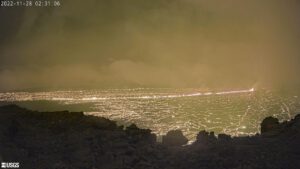 An eruption began at Mauna Loa in Hawaii. Around 11:30 p.m. HST (10:30 a.m. UCT), an eruption fissure opened in the Moku’āweoweo summit caldera. Lava is erupting from it, flooding the floor of the caldera. The activity is so far limited to the summit caldera and does not pose a threat to residents. Nevertheless, the alert status has been raised to “red.” Volcanologists emphasize that winds may blow volcanic gases and possibly fine ash and Pele’s hair. Health authorities are in close contact with the HVO and close monitoring is being done to see if any health hazard develops for humans and animals. As early as October, residents were warned to prepare for evacuations if a volcanic eruption occurred at Mauna Loa. If cracks form on the volcano’s flanks, then there is danger to residents living near the volcano. Lava at Mauna Loa is usually thin and flows quickly.
An eruption began at Mauna Loa in Hawaii. Around 11:30 p.m. HST (10:30 a.m. UCT), an eruption fissure opened in the Moku’āweoweo summit caldera. Lava is erupting from it, flooding the floor of the caldera. The activity is so far limited to the summit caldera and does not pose a threat to residents. Nevertheless, the alert status has been raised to “red.” Volcanologists emphasize that winds may blow volcanic gases and possibly fine ash and Pele’s hair. Health authorities are in close contact with the HVO and close monitoring is being done to see if any health hazard develops for humans and animals. As early as October, residents were warned to prepare for evacuations if a volcanic eruption occurred at Mauna Loa. If cracks form on the volcano’s flanks, then there is danger to residents living near the volcano. Lava at Mauna Loa is usually thin and flows quickly.
Volcano San Miguel increases activity
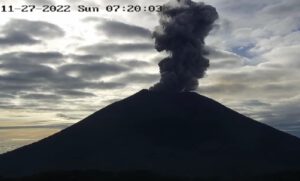 As reported by the government agency MDMA, the volcano San Miguel in El Salcador increased its activity over the weekend and doubled its previous ejection heights of tephra. During particularly strong eruptions, the volcanic ash rose to 1100 m above crater level. The eruptions had a VEI of 1. Nevertheless, the eruptions were described as phreatic. Volcanologists report that they are closely monitoring the volcano’s activity and watching for indications of whether there is a transition to stronger phreatomagmatic eruptions.
As reported by the government agency MDMA, the volcano San Miguel in El Salcador increased its activity over the weekend and doubled its previous ejection heights of tephra. During particularly strong eruptions, the volcanic ash rose to 1100 m above crater level. The eruptions had a VEI of 1. Nevertheless, the eruptions were described as phreatic. Volcanologists report that they are closely monitoring the volcano’s activity and watching for indications of whether there is a transition to stronger phreatomagmatic eruptions.
Mount Etna opened new Vent
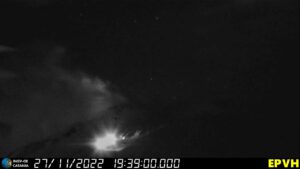 Yesterday evening, Etna opened a vent at the base of the Southeast Crater cone. On the LiveCam you can see a bright spot coming from a short lava flow. According to INGV, the vent opened at 17:00 in the northeast, at an altitude of 2800m. We have observed similar events several times in the last years. Often there was a paroxysm after a few days of lava flow activity. Tremor and seismicity are so far inconspicuous, the lava seems to escape without much pressure. It is quite possible that this is the material that intruded under the crater 2 weeks ago.
Yesterday evening, Etna opened a vent at the base of the Southeast Crater cone. On the LiveCam you can see a bright spot coming from a short lava flow. According to INGV, the vent opened at 17:00 in the northeast, at an altitude of 2800m. We have observed similar events several times in the last years. Often there was a paroxysm after a few days of lava flow activity. Tremor and seismicity are so far inconspicuous, the lava seems to escape without much pressure. It is quite possible that this is the material that intruded under the crater 2 weeks ago.
Cotopaxi in Ecuador erupted volcanic ash
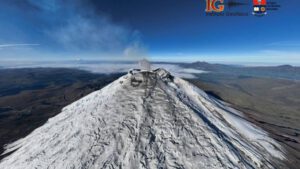 On Thursday morning, many astonished eyes turned in the direction of the Cotopaxi summit, because at night there must have been an ash eruption that turned the snow at the volcano’s summit gray. The volcanologists from IG go wrote in their report that it was only a small ash cloud that had risen up to 300 m above crater level. It is believed that the ash was produced in an exhalation that also emitted a lot of gas. A clue to the exhalation was provided by a weak tremor signal recorded by seismographs around 6:30 p.m. local time. Although it was only a small eruption, the activity worries the people of the region. Cotopaxi is the second highest volcano in Ecuador and one of the highest active fire mountains on Earth. The Andean volcano rises 5897 meters above sea level and its summit area is covered by a glacier. Therein also lies the greatest danger of Cotopaxi, because large eruptions could melt the ice, creating lahars. They could reach the suburbs of Quito, because the capital of Ecuador is only 50 km away from the volcano.
On Thursday morning, many astonished eyes turned in the direction of the Cotopaxi summit, because at night there must have been an ash eruption that turned the snow at the volcano’s summit gray. The volcanologists from IG go wrote in their report that it was only a small ash cloud that had risen up to 300 m above crater level. It is believed that the ash was produced in an exhalation that also emitted a lot of gas. A clue to the exhalation was provided by a weak tremor signal recorded by seismographs around 6:30 p.m. local time. Although it was only a small eruption, the activity worries the people of the region. Cotopaxi is the second highest volcano in Ecuador and one of the highest active fire mountains on Earth. The Andean volcano rises 5897 meters above sea level and its summit area is covered by a glacier. Therein also lies the greatest danger of Cotopaxi, because large eruptions could melt the ice, creating lahars. They could reach the suburbs of Quito, because the capital of Ecuador is only 50 km away from the volcano.
Shiveluch erupts volcanic ash
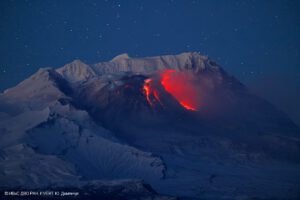 On Kamchatka, the Shiveluch is erupting volcanic ash. According to VAAC, it rises to an altitude of 4000 m and drifts towards the east. KVERT attests that the volcano has increased activity and indicates that the dome continues to grow. MIROVA detects moderate thermal radiation. Red glow is visible at night and incandescent debris avalanches are coming off. Activity may continue to increase, producing pyroclastic flows. The photo was taken on 19 November by Yu. Demyanchuk (KVERT).
On Kamchatka, the Shiveluch is erupting volcanic ash. According to VAAC, it rises to an altitude of 4000 m and drifts towards the east. KVERT attests that the volcano has increased activity and indicates that the dome continues to grow. MIROVA detects moderate thermal radiation. Red glow is visible at night and incandescent debris avalanches are coming off. Activity may continue to increase, producing pyroclastic flows. The photo was taken on 19 November by Yu. Demyanchuk (KVERT).
Hunga Tonga-Hunga Ha’apai: Eruption was very strong
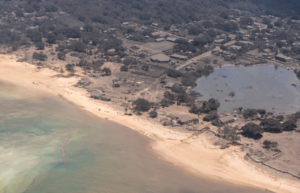 The eruption in Tonga does not want to end. VAAC Darwin registered another eruption cloud over Tonga at 12:00 Zulu time. The altitude indication gives a range between 12,000 and 19,000 m.
The eruption in Tonga does not want to end. VAAC Darwin registered another eruption cloud over Tonga at 12:00 Zulu time. The altitude indication gives a range between 12,000 and 19,000 m.
It is now clear that the damage to the islands of the Kingdom of Tonga is greater than first thought. The tsunamis reached heights of up to 120 cm and caused destruction on the coasts. Most of the islands are covered in volcanic ash and cut off from communication. Saturday’s eruption was also much stronger than initial reports indicated. Volcanic ash was detected at 39 km altitude. The blast wave from the explosion passed around the Earth 4 times.
What made the eruption so strong?
Before the big eruption on Saturday, there were two moderate eruptions and several small ones. The series began on December 20. These eruptions were Surtseyan eruptions in which water already had a hand. Then, in the large eruption, a large amount of seawater probably entered the volcano’s conveyor system and explosively vaporized. Another possibility is that an injection of fresh melt into the magma body occurred, resulting in a reaction between two different magmas. The blast wave from the explosion circled the globe 4 times, causing gravitational shock waves that reached almost into space.
Volcano News 01/14-22: Tonga Hunga
Hunga Tonga-Hunga Ha’apai: Eruption triggers small tsunamis
State: Tonga | Coordinates: -20.545; -175.393 | Eruption: Surtseyan
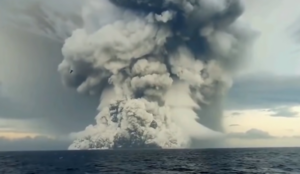 For some days it had become quite quiet around the island volcano Hunga Tonga-Hunga Ha’apai, but yesterday it reported back with a powerful eruption. The volcanic eruption is so strong that small tsunamis arrive on the main island of Tonga. The wave heights are a little less than 60 cm. This may not be much, but even small tsunamis can push a few 100 meters inland and cause damage along the coasts. But there are no reports about that at the moment. In any case, the region is on tsunami alert. The height of the ash column is impressive: according to VAAC Wellington, it rose to almost 18,000 meters. The last detected eruption cloud still reached a height of 15,000 m.
For some days it had become quite quiet around the island volcano Hunga Tonga-Hunga Ha’apai, but yesterday it reported back with a powerful eruption. The volcanic eruption is so strong that small tsunamis arrive on the main island of Tonga. The wave heights are a little less than 60 cm. This may not be much, but even small tsunamis can push a few 100 meters inland and cause damage along the coasts. But there are no reports about that at the moment. In any case, the region is on tsunami alert. The height of the ash column is impressive: according to VAAC Wellington, it rose to almost 18,000 meters. The last detected eruption cloud still reached a height of 15,000 m.